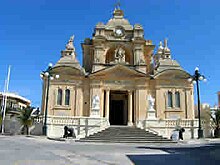Nadur
| coat of arms | map |
|---|---|

|
|
| Basic data | |
| State : | Malta |
| Gzejjer : | Gozo and Comino |
| Distretti : | Gozo and Comino |
| Area : | 7,174,466 km² |
| Residents : | 4156 (December 31, 2018) |
| Population density : | 579 inhabitants / km² |
| ISO 3166-2 : | MT-37 |
| Website : | www.nadur.gov.mt |
| politics | |
| Mayor : | Charles Said ( PN ) |
Coordinates: 36 ° 2 ′ N , 14 ° 18 ′ E
Nadur (or In-Nadur ) is a city in the northeastern part of the island of Gozo , which is part of the Republic of Malta . It has 4156 inhabitants (as of December 31, 2018).
Nadur is a member of the European Charter - Villages of Europe , a group of rural communities from all 28 EU countries.
history
The Maltese word nadur means “view” in German and is derived from the Arabic word nadara . Hence the city's motto.
There are no archaeological documents that provide information about the colonization of Nadur by its first inhabitants. However, it is known that farms scattered in the plateau and its surroundings existed long before the elevation of this area to a parish in 1688. The only traces of prehistoric times were a number of large, flat stones found in a field between San Blas Bay and Daħlet Qorrot . According to the book “Geschichte Gozos” by GPF Agius de Soldanis, the originally roofed structures, which no longer exist today, were a kind of god temple. There is also the opinion that these stone slabs were not brought by human hands, but by giants to where they are today. Nadur is said to have been founded in Greek times. A bronze statue of Apollo , which was found in Nadur in 1744, is cited as proof of this .
Throughout its history, Nadur has played a huge role in defending the island against the corsairs , hence the name (lookout). During the reign of the Knights of Malta , Grand Master Nicholas Cotoner built a watchtower, which the two towers in San Blas and Daħlet Qorrot point to. It is known as the Ta 'Sopu Tower .
Another watchtower in Nadur is the Ta 'Kenuna Tower , built by the British in the mid-19th century. It served as a telegraph connection between the islands of Malta and Gozo . From the top of this tower you can see most of Gozo, Comino and the northern part of Malta.
Nadur today
With more than 4000 inhabitants, Nadur is the second largest and one of the most important cities in Gozo after Victoria. A large part of the population emigrated after World War II in the United States , to Canada or Australia from.
There are still quite a few farmers in Nadur - mostly part-time farmers. Many local fruits such as plums, peaches, apples, oranges and lemons come from the orchards of Nadur. These products have been the basis of economic contacts with Malta for the past 3000 years. Even today, the trade in citrus fruits still plays a major role; most of them are grown in Nadur. Lately, the municipality has encouraged the planting of olive trees from Italy as the number of these trees has decreased significantly in recent years.
A large part of the other residents of Nadur earn their living as fishermen or seamen. This craft was already widespread at a time when fishing methods were rather simple in Malta. Quite a few fishermen from Nadur drowned in storms.
The parish of Nadur
The religious festival of Nadur, Mnarja , is celebrated on June 29th. The festival was very popular with honeymooners and its name refers to the beginning of summer. It is derived from the Italian word luminaria (English: lighting). The festival is deeply rooted in the Maltese summer tradition.
The statue of Peter and Paul in the church there was carved in Marseille in 1882 . On Good Friday , some statues are carried through the streets in the procession depicting the passion and crucifixion of Jesus Christ . On Easter morning they are followed by a statue of the risen Christ.
Nadur was raised on April 28, 1688 by Bishop Cocco Palmeri to its own parish. Bernhard Haber was their first pastor. The community at that time also included Għajnsielem , Qala and Comino and 532 souls lived there. The parish church of St. Peter and Paul is an important work of art in terms of architecture and church painting. It has rich marble work and was built in the place of an earlier, smaller church at the highest point of the city.
The Basilica of St. Peter & Paul
The construction of today's church began on September 28, 1760. It was designed by the Maltese architect Giuseppe Bonniċi (1707–1779).
In 1907 it was renovated, with the aisles, the dome and the facade designed by Prof. FS Sciortino in the style of the Italian Renaissance . The ceiling painting depicting scenes from the life of Saints Peter and Paul was created by Lazarro Pisani (from Żebbuġ ). The architectural decorations are the work of the Italian Pio Cellini. The renovation was mainly carried out by Archpriest Martin Camilleri.
On June 26, 1967, the church in the Diocese of Gozo was opened by Pope Paul VI. raised to the basilica .
The parish has its own radio station, Radjuluminaria .
Town twinning
There are partnerships between Nadur and the Italian municipality of Cicciano in Campania ( metropolitan city of Naples ).
Nadur is also the representative of Malta in the European Charter - Villages of Europe , an association of rural communities from all 28 EU countries.
Web links
Individual evidence
- ↑ StatDB of the National Statistics Office Malta , accessed on August 1, 2020



